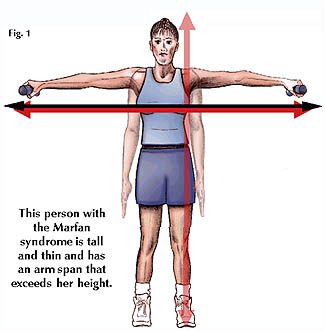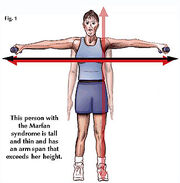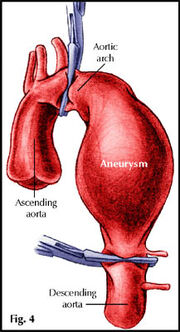mMarfan Syndrome[]
Symptoms:[]
Marfan Syndrome is a disease that affects the bodies connective tissues. It affects its patients major arteries. The aorta often dilates which can weaken the aortic wall. This can cause the wall to tear and blood to leak into the layers of the blood vessel. This can also lead to aneurisms. If this disease is severe, blood can leak backwards into the valves of the heart causing the heart to enlarge. This enlargement of the heart can cause abnormal heart sounds that can be heard by the patient's doctor using a stethoscope.
Other Symptoms of Marfan Syndrome:
- Tall and slender build.
]
- A breastbone that protrudes outward or dips inward.
- Lung changes.
- Skin changes.
- Dental Problems.
- Heart murmers.
- Problems with eyesight, such as nearsightedness.
- A curved spine
- dialtion of aorta / weakenesses in heart muscle
[1]]

Detection:[]
The only true single test to diagnose Marfan Syndrome is a genetic test. This test is not often administered because it is costly and not as prevalent. The only way to diagnose the disorder is through a series of tests. Those who have this disorder have similiar problems and symptoms so a diagnosis can be made. Chest X-rays are used to examine the lungs and heart for weaknesses. Electrocardiograms are also used to examine for problems, weaknesses, or defects in the heart muscle. Another problem associated with those with Marfan syndrome is dural ectasia which is a bulging in the spinal column. It is a characteristic of connective tissue disorders. This can be tested for by CT or MRI scans. Often the aorta is examined to check for leakages and dialations of the aorta wall. Also respiratory problems and weakness of the lungs can be attributed to Marfan Syndrome. Also a combination of symtoms such as nearsightedness, leaking heart valves, bones that are long and thin, and a very tall thin build can help diagnose this problem.
 [2]
[2]
Treatment and Medication:[]
A patient with Marfan Syndrome will need to make sure to keep his or her heart as healthy as possible because of the symptoms associated with this disease. A patient is normally encouraged to have regular chest x-ays and dopler echo tests to monitor the condition of the heart. Other treatment depends on the severity of the patient's symptoms. Some patients need medication to keep their blood pressure and heart rate down and in severe cases where the heart's valves are greatly affected, surgery may be needed to repair the damage. Patients who develop severe scoliosis may need a back brace to help straighten out the spine. Patients with eye problems may need corrective lenses or surgery and people with dental problems may need braces or dental surgery.
Inheritance:[]
Marfan Syndrome is an autosomal dominant disease. The disease is usually inherited from one parent that has Marfan Syndrome. The disease does not have a gender bias. This means that the disease affects a similar amount of males and females. If a child inherits Marfan Syndrome his or her siblings also have a fifty percent chance of inheriting Marfan Syndrome. If both a child's parents have the disease, he or she has a seventy-five percent chance of inheriting Marfan Syndrome. It is not possible to be a genetic carrier for Marfan Syndrome and not have the disease
.[3]
How Common is Marfan Syndrome?:[]
Marfan Syndrome occurs in 1 in every 5,000 children born worldwide.
Citations:[]
www.americanheart.org/presenter.jhtml?identifier=4672
www.my.cleveland.org/heart/disorders/aorta_marfan/marfan.aspx
www.mayoclinic.com/health/marfan-syndrome/DS00540/DSECTION=treatments-and-drugs




